
16 minute read
A NEW WORLD
These alumni went face to face with the coronavirus and came away changed
There are as many different experiences of this coronavirus period as there are people.
Some of experiences depend on place. In Bradford’s home of McKean County, there had been only 11 total COVID-19 cases reported by late May. Where residents in the spring could self-distance by hiking, fishing and biking, it was a different world from where people were locked down in urban apartments.
Likewise, experiences depend on profession. For those in the trenches this spring – answering code blues in hospitals, placing last calls to relatives – the outside world might as well have been another planet.
by KIMBERLY WEINBERG, Portraits editor
MELISSA DIBBLE ’15
Travel nurse St. Joseph’s Wayne Hospital
WAYNE, N.J.
At home in Marshburg – a hilltop community between Bradford and the Allegheny National Forest – there was snow on the ground.
Melissa Dibble ’15, a travel nurse far from home in hard-hit northern New Jersey, had heard it from her husband on their morning phone call after she got off her night shift at St. Joseph’s Wayne Hospital. These morning phone calls are her main connection to a world outside of the hospital and the nearby hotel where she stays while working as a travel nurse.
In travel nursing, nurses coordinate with a recruiter to take short-term contracts to work where they are most needed. Dibble had been assigned at UPMC Hamot Medical Center in Erie, Pa., when the hospital stopped performing non-emergency surgeries and seeing routine patients in order to prevent the spread of the COVID-19 pandemic. Without as many patients, fewer nurses were needed, and the hospital suspended her contract.
Dibble thought hard about what to do next and felt called upon to help those suffering from the coronavirus in the greater New York City area. Her husband, an Iraq War veteran, understood her desire.
“He said this was my Iraq. He didn’t really want me to go, but he understood why I wanted to,” she said. She told her recruiter, who responded, “This hospital in New Jersey just sent out a huge SOS.”
“I didn’t even ask how much they were paying,” Dibble said. She started two days later on April 8 and after a day of orientation and a crash course on the hospital’s computer system, she found herself in the heart of a community in crisis.
COVID-19 hospitalizations in Northern New Jersey would peak a week later. While the hospital had enough personal protective equipment, rumors were quick to start. One staff member would overhear another having a conversation about protective equipment and think there was a shortage. Soon, everyone was reusing their masks or gowns until a supervisor asked why and the dangerous game of telephone was discovered.
The hospital was also short of mechanical IV pumps. “In nursing school, they have you count your drip rates,” Dibble said. It was a skill she was glad she had since nurses were now manually doing the work of the mechanical pumps.
The hospital, she said, is in an area with a higher-than-average poverty rate where the virus had spread quickly through immigrant families living in multi-generational homes. Luckily, the staff also included a large contingent of multilingual doctors, nurses and aides who could quickly translate for a patient.
Dibble found the capriciousness of COVID-19’s path for any one patient hard to handle.
“If you’re not going to get better, I don’t want people to pass away alone,” she said. “You never know when it is the end. That’s the mystery.”
Often, she can only see each patient once or twice per shift, and she tries to make the most of her time with each, being upbeat and talking to them. Each time she enters a patient’s room, it requires washing and donning a new set of PPE.
“You don’t want to be going in and out of these rooms, and you want to conserve your equipment,” she said.
To illustrate the unpredictability of the disease, she told the story of one case.
“I went in to see my patient and said, ’Hi, grandma.’ I always talk to everybody because you can’t just pop in. It’s all about humanity. She’s looking at me, and everything’s fine. Her pulse is good. Her lungs are clear.
“I’m happy and leave to go into the next room, where a man is actively passing. I am talking to him and giving him medications to ease his transition. I know the end is close, and I’m telling him that it’s OK.”
She left him and went to a third room. When she came out of the third room, the secretary at the nurses’ station told her that the first patient had stopped breathing.
“I was just there. I gowned back up, and she was gone. Her vital signs had been perfectly fine,” she said with dismay.
“This has definitely been humbling. You definitely learn not to take things for granted.” She hopes others can realize how bad the situation was in the hardest-hit places. “In a small way, I was just like some people. I was naïve. I didn’t see it in McKean County.”
Dibble said she is not a political person, but she’s had a hard time reconciling with those protesting to open the country faster.
“I’ve been reading the news, and I’ve had a hard time with this. I’ve seen so many people pass away. Here I am standing in a hallway littered with paper gowns. It kind of crushes you sometimes.”
Ali Rinfrette ’18
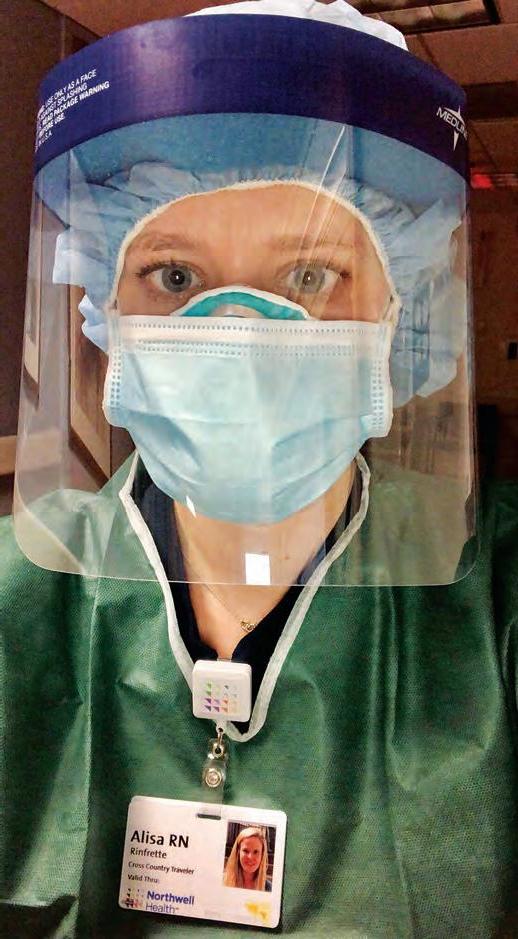
ALI RINFRETTE ’18
Travel nurse North Shore University Hospital
MANHASSET, LONG ISLAND, N.Y.
Ali Rinfrette ’18 has been working at St. Vincent Hospital in Erie, Pa., for the last year.
“Things weren’t too bad in Erie,” she said. “We had one floor designated for corona patients. I had heard how bad it was in New York, and – being young and healthy – I felt obligated to go. I felt like it was the right thing to do.”
Rinfrette and her supervisors at St. Vincent also viewed a stint in a large metropolitan hospital as a learning opportunity. “Our nurse educator told me to write everything down,” she said.
Rinfrette contacted a travel nursing recruiter, who placed her at North Shore University Hospital in western Long Island. Although hard hit, it also turned out to be a progressive hospital affiliated with three medical schools.
As a result, there are many clinical trials going on with COVID-19 patients at North Shore, testing the effectiveness of treatments ranging from plasma antibodies to the over-the-counter heartburn drug Pepcid. Because of the trials, she has had to meticulously record patient responses to the different treatments.
She also has had the opportunity to watch choreographed “proning teams” in action. The teams turn over intubated COVID-19 patients and their array of wires and tubes. Flipping intubated patients onto their stomachs has been shown to help them breathe more easily.
In individual rooms, each patient has an Amazon Echo Show, a smart display screen that uses Amazon’s voice-activated personal assistant Alexa so that patients can play music, talk to staff outside of their room and even video chat with family when they feel able. The device gives patients a small bit of autonomy, Rinfrette said. “I think it’s a nice thing to have.”
Her hotel is home mostly to other health care workers. On days off, she runs outside and reads. One night, she drove to Times Square just to see it empty. “It’s surreal. It really is,” she said.
She also listens to the 7 p.m. clap, when New Yorkers come out of their homes and cheer for health care workers.
“There’s a tunnel at the hospital that all of the nurses walk in and out of,” she said. “Every night there are gifts and people lined up. It’s a good feeling.”
Another good feeling, she said, is when someone is able to be removed from the ventilator and the hospital plays the Beatles’ “Here Comes the Sun.”
“When someone is discharged, everyone comes out and claps, and it’s really cool to see. (The disease) is so scary, but it’s also awesome to be here helping.”
The hardest part, she said, is seeing patients struggling and not being able to help them or let them see their families.
“Sometimes, there’s nothing we can do,” she said. Sometimes, the only thing left for her to do is help a patient’s family say goodbye via videophone.
“That’s very hard. There’s not really a way to prepare or train for something like that.
“In some areas where it’s not bad, people don’t realize how sick people are and that this is real and that we need to be safe. I wish people could see how bad this is and how bad it could really get. I knew it was real, but it’s very eyeopening to be here.”
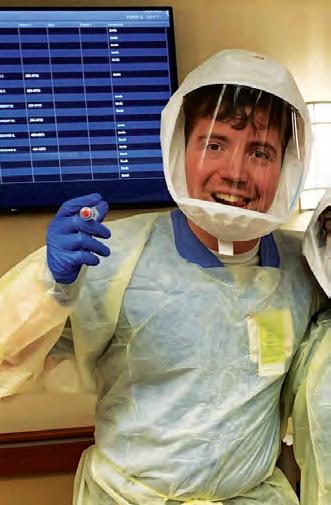
Richie Brand ASN '15, BSN '16
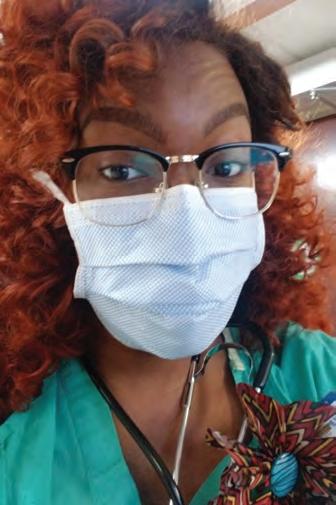
Jasmine Reeves '08
RICHIE BRAND ASN ’15, BSN ’16
Registered nurse UPMC Mercy Hospital
PITTSBURGH
JASMINE REEVES ’08
Post-op nurse Atrium Health system
CHARLOTTE, N.C.
Outside of the New York metropolitan area, many hospitals prepared for a COVID-19 rush that never came.
Before the pandemic, Richie Brand ’16 worked with neurotrauma patients – those who had back and spine surgery – at UPMC Mercy near downtown Pittsburgh. After Pennsylvania ordered that “elective” surgeries be postponed, his floor converted to a ward for COVID-19 patients.
However, he never saw his floor more than half full. Patients suspected of being positive for the coronavirus were also sent to his floor for testing.
“It was very emotional to see people waiting all night for the results of their test. If their test was negative, we were allowed to tell them, and it was like the first breath they’d taken in days,” he said.
Those who were positive were sent home to selfquarantine, if they were well enough. If not, they occupied hospital rooms where they could receive oxygen and be closely monitored. Those who arrived very ill were tested in the emergency room and sent to intensive care.
Before Mercy started receiving COVID-19 patients, Brand had doubts about what he would have to face. “I wasn’t sure I’d be able to handle it,” he admitted. “But this has made me think I could handle more.”
He feels a bit guilty for not having helped more or sicker patients. “I feel like I’m not really doing my part,” he said.
In Charlotte, N.C., Jasmine Reeves ’08 and her twin sister, Jada ’08, work with surgical patients. Jasmine was worried as the coronavirus crisis mounted in New York.
“In our daily huddle, we talked about rising numbers and dwindling numbers of personal protective equipment. We were watching the news and looking at the experience of other nurses.”
At first, the hospital told Jasmine Reeves to change her mask between every patient to prevent
the spread of COVID-19. Then, she was told to only use one mask a day in order to conserve them. Each nurse had two N95 masks. They would wear one with a regular blue disposable mask over it to protect the N95 while the other was out being cleaned with hydrogen peroxide and ultraviolet light.
“We didn’t see the huge surge that we expected to see,” she said. The precautions, however, prevented her from letting families stay with surgical patients.
“People could become very volatile when they couldn’t visit their loved ones in the hospital,” she said. “I would hope that everyone understands this is a first for all of us. We’re doing our best to be with patients when their family members can’t be there.
PHILIP JACOBUS ’74
Chief Executive Officer DOTmed.com medical marketplace
MANHATTAN, NEW YORK CITY
While not working in a hospital, Philip Jacobus ’74 found himself personally and professionally at the center of the COVID-19 pandemic.
He is the chief executive officer of DOTmed.com, a website used by medical professionals to find equipment, parts and service companies. On an average day, he said, more than 24,000 people visit the site, where there are more than 750,000 postings.
With a large number of business contacts in China, Jacobus was able to anticipate what might happen, and on March 1 – two weeks before New York City executed a stay-at-home order -- had his workers move from his company’s office in the financial district of Manhattan to their homes. He and his wife left their loft in Tribeca and moved to their country home in upstate Woodstock, N.Y.
“At the outset of the coronavirus, we realized that our site would be a valuable resource,” he said. “We helped match hospitals with extra capacity with hospitals with higher demand. This was particularly true in New York City.
“We helped hospitals find ventilators, anesthesia machines that can also be used as ventilators in a pinch, hospital beds and monitors.”
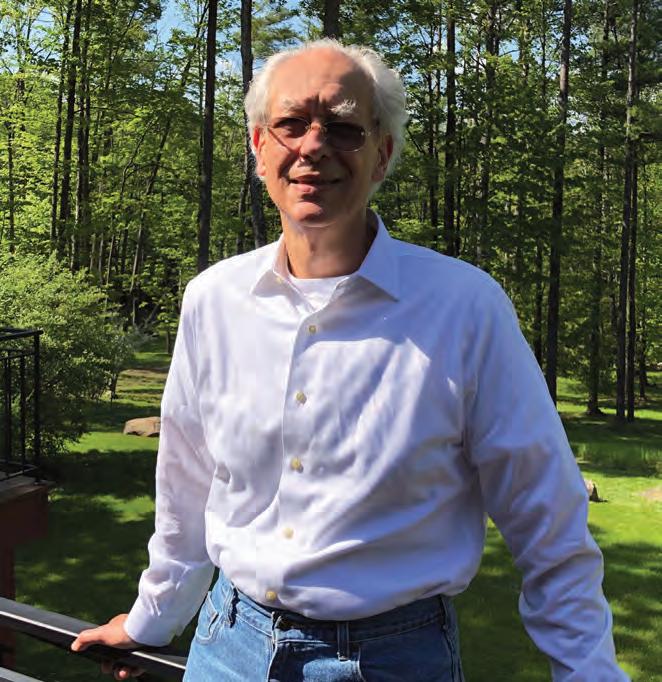
Philip Jacobus '74
He said a particularly popular item was disposable finger oxygen sensors, so that the sensors would not be moved from patient to patient, potentially spreading the virus.
Business, for the most part, hasn’t changed, he said. Traffic is up a bit on the website, which one would predict. He’s paying rent on an office in the financial district that stands empty.
“I have had to drive into town a few times, and for the most part, the city has been deserted and the people who are walking around are polite and observing social distancing,” he said. “Everyone wears masks, and, for the most part, everyone has been respectful.”
TAMI MINNIER ’81
Chief Quality Officer UPMC
PITTSBURGH
If she stopped to think about the task at hand – coordinating the COVID-19 safety response for UPMC’S 40 hospitals and 90,000 employees – it might freak her out a bit, which would be totally understandable.
Good thing Tamra Minnier ’81 doesn’t have time to consider it. It helps that Minnier has been planning for infectious diseases and their impact and building a network of health professionals she calls friends for years.
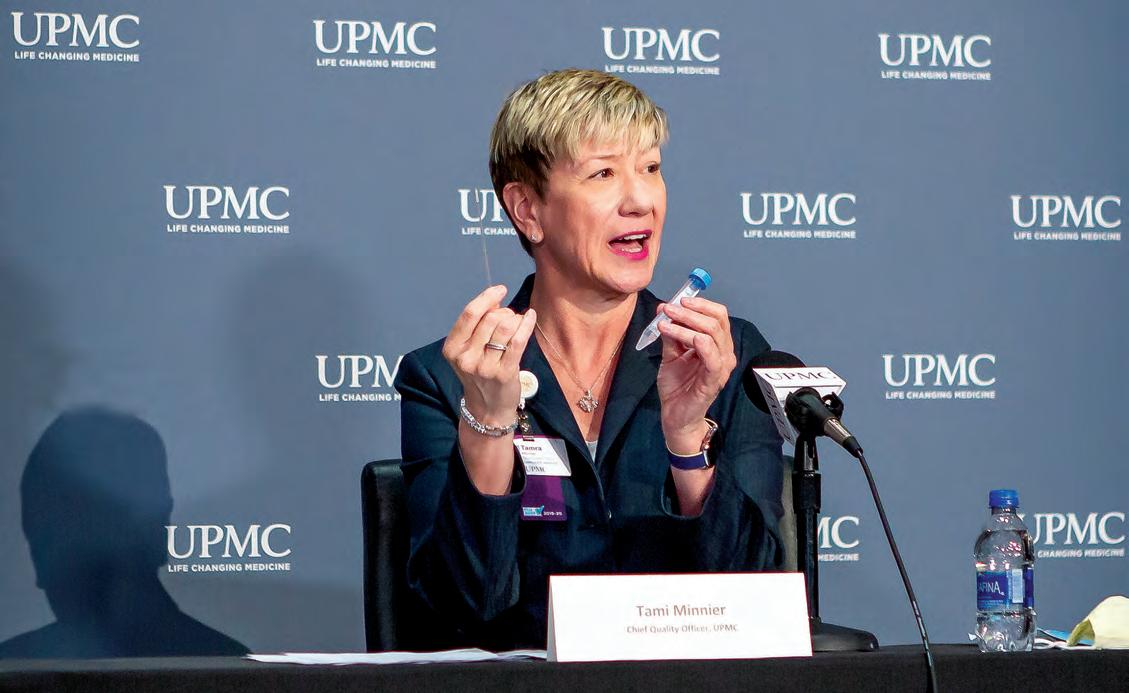
UPMC
Her willingness to pick up a phone and talk through an idea has helped her cut through red tape. So have daily videoconferencing calls of up to 400 leaders throughout the UPMC system, where many of the system’s innovations got their start.
Finally, there’s the system’s affiliation with the University of Pittsburgh. UPMC, Minnier said, is the country’s largest academic health system and has access to top epidemiologists, virologists and other researchers.
One of the first problems Minnier and her team had to solve was testing, which was inadequate throughout the state. Because of the hospital system’s ties to a research-focused medical school, UPMC decided not to wait on the government for tests and developed its own that it could also process in-house.
Minnier said that although the lab is not approved by the U.S. Food and Drug Administration to process tests for other groups, it was able to handle testing for all of UPMC’s hospitals, putting them weeks ahead in their testing capacity.
Another example of quick work by a deep network involved creating the flexible plastic swabs used to reach deep into a subject’s sinuses to test for the virus, which were starting to run low at hospitals everywhere.
On her daily noon teleconference call, she held one up to the camera. “We need these,” she said. “Oh,” someone piped up. “Radiology has 3-D printers we use to model tumors for surgeons. We can make some.” By mid-April, UPMC was testing all patients and front-line health care workers regularly. Another problem solved.
Minnier makes it sound so easy, but clearly, there’s a combination of knowing what the people and units in her organization do and her willingness to make decisions.
“You just do,” she said of her knack for cutting through red tape. “The key is knowing enough about your organizational culture to know which people need to be engaged to get it done.”
At a time when few were sounding confident about their ability to handle the virus, Minnier didn’t hesitate to say, “We’ve got this.”
“Just because I say that, doesn’t mean we’re perfect,” she said. When one solution doesn’t work, she looks for another and is confident it will appear.
LT. MATT DELANEY ’00
Physician Assistant U.S. Army Reserve Urban Augmentation Medical Task Force
EDISON, N.J.
Like Tami Minnier, Lt. Matt Delaney, belongs to an organization that takes pride in solving tough problems – the U.S. Army Reserve.
While the virus gathered steam in mid-March, a high-level Army reserve officer dreamed up a new kind of unit based on the mobile field hospitals the reserves deploy in battle zones.
On April 1, Delaney, a former U.S. Army medic who had rejoined the reserves last July because of its need for his expertise as a physician assistant, received orders to report the next day to Milwaukee, where the Army Reserve was putting together four new Urban Augmentation Medical Task Forces.
Made up of 85 members each, the units could deploy to set up field hospitals supplied by the Federal Emergency Management Agency.
Delaney and his inaugural unit landed at the New Jersey Convention and Exposition Center in Edison, N.J., where tractor trailers awaited with the makings of two 250-bed field hospitals.
Having only met for the first time days before, the team’s members quickly tapped into military organizational structure to get the hospital set up inside the convention center within days.
Delaney had two jobs within the hospital – serving every third or fourth day as the overseeing medical officer for a shift and coordinating patients’ transfers to the field hospital from the surrounding hard-hit civilian hospitals.
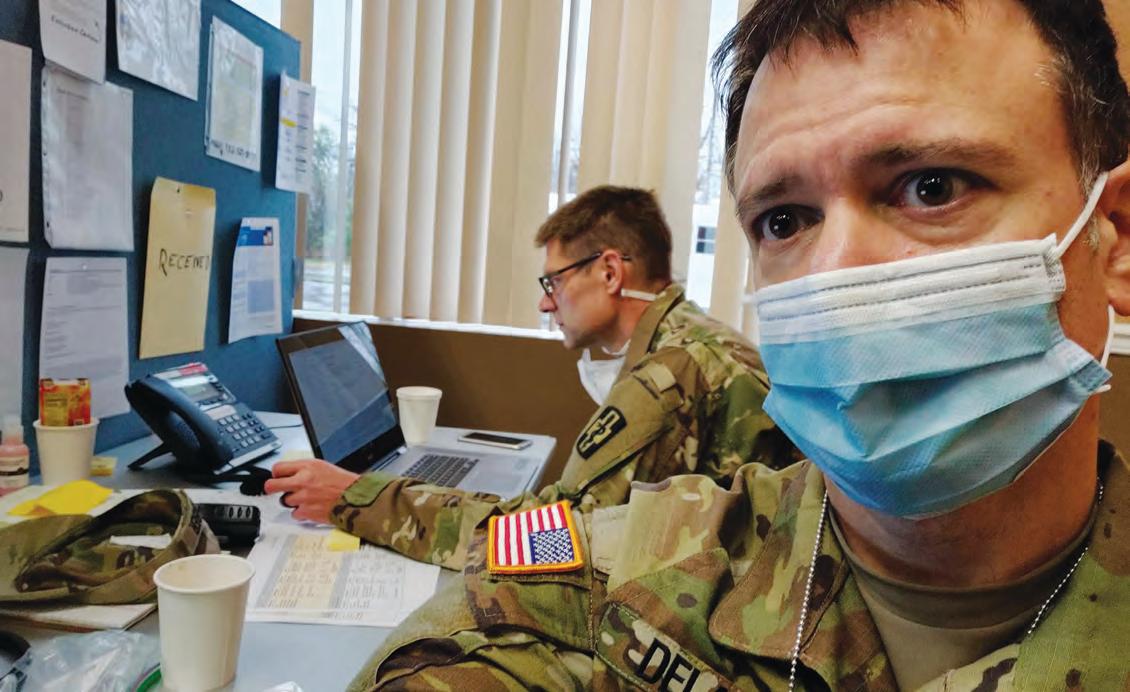
Most days, Delaney worked in the command center coordinating the transfer of patients to the field hospital. His daily contact with many hospitals gave him a unique perspective of how the virus was spreading, how it was being treated, what patients were responding to and what they weren’t.
Because of that, he was included in a nightly videoconference meeting of Army physicians to share such information.
One of the most difficult things, he said, was the vast amount of unknowns about the virus and how it works in the body and the changing understanding of how it worked.
“Initially we thought it was a viral illness and to expect those kinds of problems,” he said. “But then we saw a second inflammatory phase of the illness and how it could cause microscopic blood clots everywhere. We didn’t know any of that initially.”
In total, Delaney’s unit treated more than 100 patients before he returned home to Tampa, Fla.
He is still in awe of what his new unit was able to accomplish. “These units didn’t exist in midMarch,” he said, “and two weeks later we were standing there ready to take patients.”
The reserve will keep the units for deployment for other future natural and medical disasters. The units are now an option for “any time you need to waive a magic wand and make a hospital appear.”



